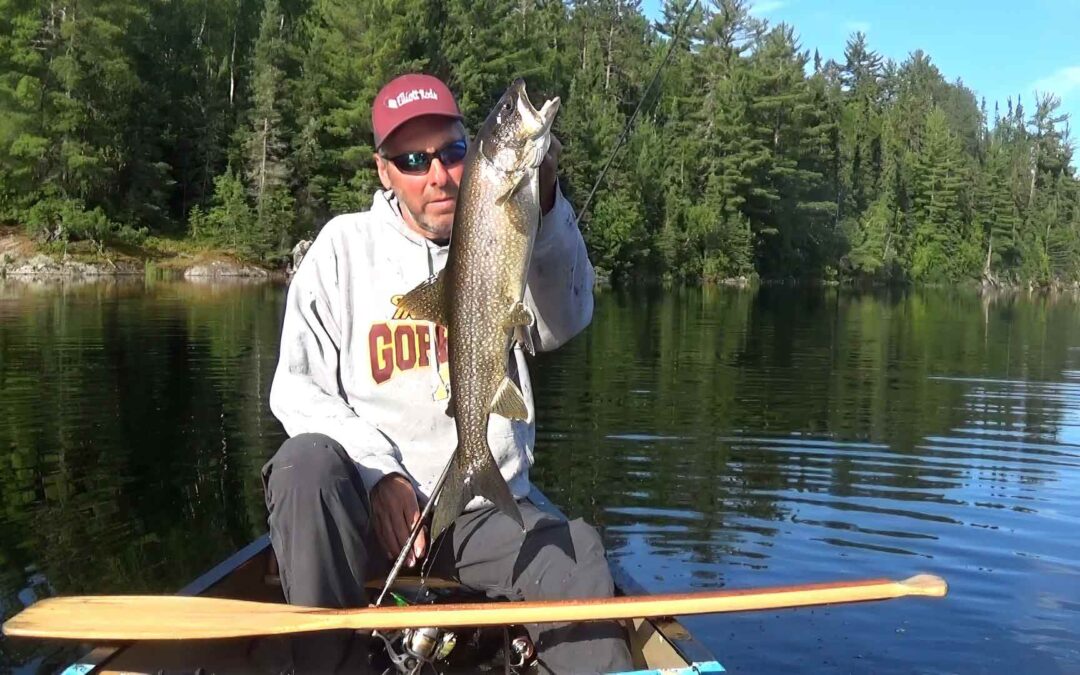BWCA Quetico Fishing
Lake Trout Fishing in Canoe Country with Video
Big Schools of Lake Trout
It’s a common practice to troll for lake trout when in deeper Quetico and BWCA lakes and it works. Trolling will produce lakers as you cross water on the way to your next campsite but to really target multiples of lake trout I’m talking 20-30-40 of them in a single day jigging for them is my go to method.
Trolling for Lake Trout
Trolling for lake trout in Canoe Country during June involves a medium power casting rod, 10lb test line (I like Gamma line for the record) and a selection of crankbaits or spoons. I find crankbaits to be more reliable in terms of what depth your working. A minnow style crankbait that runs 15-20 under the surface has been the top producer but I’ve had days where a fat body deep diving crank works too. One tip: use a 3 foot leader and attach it to a good barrel swivel on the main line when trolling this will prevent line spin.
Each trip is significantly different in terms of where the lakers will be located. When crossing big lake trout water the opening strategy is for each angler to run a different lure at a different depth. Lakers will come up to chase a bait. I’ve seen lake trout eat a crank at boatside. If angler 1 is catching fish at 20 feet with a deep diving minnow crank and angler 2 is shut down running at 15 then angler 2 makes a move to a 20 foot crankbait. This is a great tactic for paddling across big water. I know you’re proably asking yourself in how deep of water are the lake trout? I’ve caught them in less than 10 feet jigging and in over 200 feet suspended 20-40 feet down during June.
The next tactic also includes trolling crankbaits but now you’re running a shoreline. On shorelines what we do is once a fish is caught we stop and jig for them with a white tube or swim bait. This method has often resulted in many lake trout in a single location. Of course the wind will somewhat dictate what you can do.
Jigging for Lake Trout
Jigging lake trout is the number one way to catch many lakers in a single spot. Finding these spots can be more cumbersome but it pays off big time. I mentioned the shoreline method above. Find them with crankbaits then stop and jig them. The other effective way is to jig steep shoreline walls. When jigging for lake trout allow the bait to hit bottom and bounce it for a bit. Then snap it lightly back to the canoe. If you sense that the lure never hit bottom set the hook! You can search for lakers with jigs or spoons too. This method works best with the angler in front casting a heavy jig allowing it to hit bottom then snap it back to the canoe. This is a good method to find big schools of lake trout. Or if the wind allows you can vertical jig while drifting.
Lakers will eat your jig on the drop and they love the keep away game!
The best lake trout fishing I ever had involved bait crashing the surface. Smallmouth bass will drive bait up to the surface and sometimes the bait just wants to be on the surface but in either case chances are there are lakers under this bait. On one particular trip we were catching smallmouth bass inches under the surface over 60-70 feet of water. When the smallie action slowed we dropped jigging spoons and swim baits to the bottom and bingo, lake trout. And lots of them. A few other times we saw the tell tale signs of bait eating bugs off the surface and dropped jigs into this area and caught lakers. If you see bait hitting the surface over deep water 40 plus feet stop and jig that area!
The jig method requires a medium power rod, reel and a 1/2 ounce jig tipped with a white plastic or a silver jigging spoon. Both casting and spinning outfits are fine.
To further wet your lake trout appetite I’ll tell you we have caught over 90 lakers in a single school over a basin full of bait that we saw crashing the surface.
I hope this helps your next attempt at lake trout fishing in canoe country. Have a question? Feel free to ask in the comments or email me at pete@outsidepwr.com.


Interesting tips on catching lake trout in canoe country. I appreciate the detailed explanation of trolling and jigging techniques. Thanks for sharing.
Great tips for catching lake trout! I’ve always wanted to try fishing for them in canoe country, and this post has really inspired me.
This fishing technique seems interesting. I might have to give it a try next time I’m out on the water.
Give jigging a try. A group I know was just up there and they caught a bunch of lakers jigging!